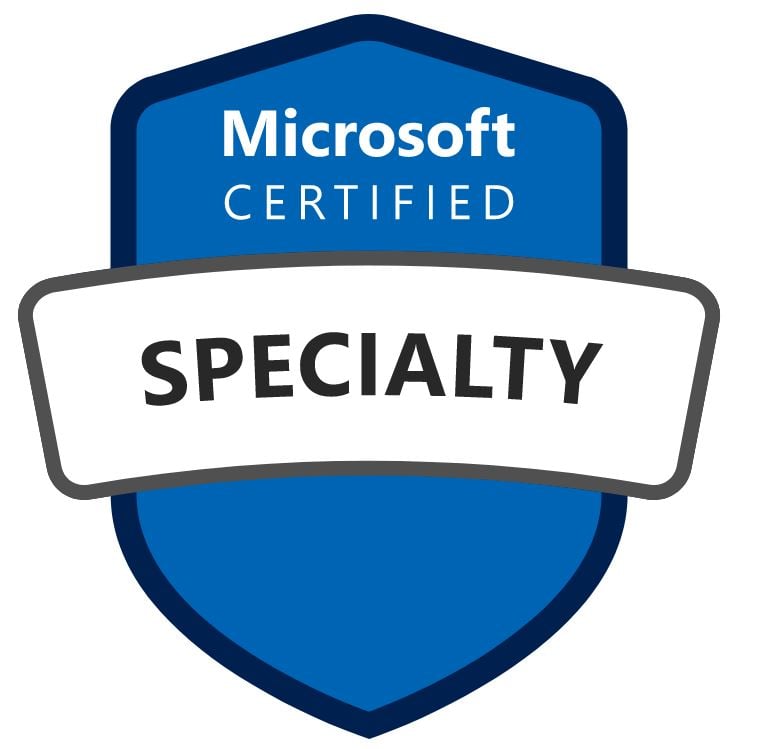Configuring and operating Windows Virtual Desktop on Microsoft Azure (AZ-140)
- Per deelnemer: € 2.145,00 excl. BTW
- Examen Upgrade: € 155,00 excl. BTW
-
4 dagen
-
Max 16 deelnemers
- Direct inschrijven

 4 dagen
4 dagen 
 Max 16 deelnemers
Max 16 deelnemers Deze AZ-140 training leert Azure administrators hoe je virtual desktop experiences en remote apps voor elk apparaat op Azure kan plannen, leveren en beheren. Je leert door een mix van demonstraties en hands-on lab experiences.
Deze cursus bereidt je tevens voor op het AZ-140 examen: Microsoft Certified: Azure Virtual Desktop Specialty.
Deze AZ-140 cursus is geschikt voor geïnteresseerden in het leveren van applicaties op Windows Virtual Desktop en optimaliseren voor gebruik in virtuele omgevingen met meerdere sessies.
Als Windows Virtual Desktop beheerder werk je nauw samen met de Azure beheerders, Azure architecten en Microsoft 365 beheerders. Als Windows Virtual Desktop beheerder ben je verantwoordelijk voor planning, deploying, packaging, updating en het onderhouden van de Azure Windows Virtual Desktop infrastructuur. Je maakt daarnaast session host images, implementeert en beheert FSLogix, bewaakt de prestaties van de Windows Virtual Desktop en automatiseert Windows Virtual Desktop beheertaken.
In deze 4-daagse training leer je:
Deze training wordt in het Nederlands en Engels gegeven. Het AZ-140 examen ‘Microsoft Certified: Azure Virtual Desktop Specialty’ wordt in het Engels afgenomen. De lestijden zijn van 9.00 tot 16.30.
Wil je het officiële certificaat ‘Microsoft Certified: Azure Virtual Desktop Specialty” certificaat behalen? Wanneer je je inschrijft voor deze training kun je een Examen Upgrade boeken voor het Exam AZ-140: Configuring and Operating Microsoft Azure Virtual Desktop. Je ontvangt dan een Examenvoucher (benodigd om deel te nemen aan het officiële online Microsoft examen).
Wij zijn blij met jou als loyale cursist. Daarom ontvang je 5% loyaliteitskorting op onze trainingen wanneer je je inschrijft voor een volgende training. Meer info over loyaliteitskorting.
Wil je hierna je Azure kennis verder uitbreiden? Bekijk ook onze andere Azure trainingen.
Module 1: Plan a Windows Virtual Desktop Architecture
In this module, you will learn how to assess existing physical and virtual desktop environments, plan and configure name resolution for Active Directory (AD) and Azure Active Directory Domain Services (Azure AD DS), and plan for Windows Virtual Desktop client deployments.
After completing module 1, you will be able to:
Module 2: Implement a WVD Infrastructure
In this module, you will learn how to manage connectivity to the internet and on-premises networks, create a host pool by using the Azure portal, deploy host pools and hosts by using Azure Resource Manager templates, apply OS and application updates to a running WVD host, and create a master image.
Module 3: Manage Access and Security
In this module, you will learn how to plan and implement Azure roles and RBAC for WVD, implement Conditional Access policies for connections, plan and implement MFA, and manage security by using Azure Security Center.
After completing module 3, you will be able to:
Module 4: Manage User Environments and Apps
In this module, you will learn how to plan for FSLogix, install FSLogix, configure Cloud Cache, deploy an application as a RemoteApp, and implement and manage OneDrive for Business for a multi-session environment.
After completing module 4, you will be able to:
Module 5: Monitor and maintain a WVD infrastructure
In this module, you will learn how to plan and implement a disaster recovery plan for WVD, configure automation for WVD, implement autoscaling in host pools, and optimize session host capacity and performance.
After completing module 5, you will be able to:
Kosten per deelnemer: € 2.145,00 excl. BTW
Max. deelnemers: 16
De genoemde cursustarieven zijn per persoon, exclusief 21% BTW ( BTW nummer wordt vermeld op de factuur), inclusief alle actuele lesmaterialen, een naslagwerk (Pdf) en een certificaat van deelname. Er zijn dus geen bijkomende kosten achteraf.
Als je je aanmeldt met een groep van vijf of meer personen voor een cursus op jouw bedrijfslocatie (in-company), dan kunnen wij een aantrekkelijk groepstarief aanbieden. Voor informatie over onze groepstarieven kun je telefonisch via 020 – 820 83 62 contact opnemen of hier een offerte aanvragen.
Werkgevers
Als werkgever kun je de volledige opleidingskosten voor werknemers aftrekken als bedrijfskosten. Dit geldt voor de opleiding zelf, maar ook voor andere kosten als boeken, inschrijfgeld, administratiekosten, het certificaat of extra begeleiding. Bij SignOn zijn al deze kosten al bij de prijs inbegrepen.
Of wil je weten of deze training bij je past. Neem dan vrijblijvend contact op via info@signon.nl of bel ons op 020 – 820 83 62.
Kies de lesmethode die het best bij je past. Deze training kun je op de volgende manieren volgen:
Meldingen